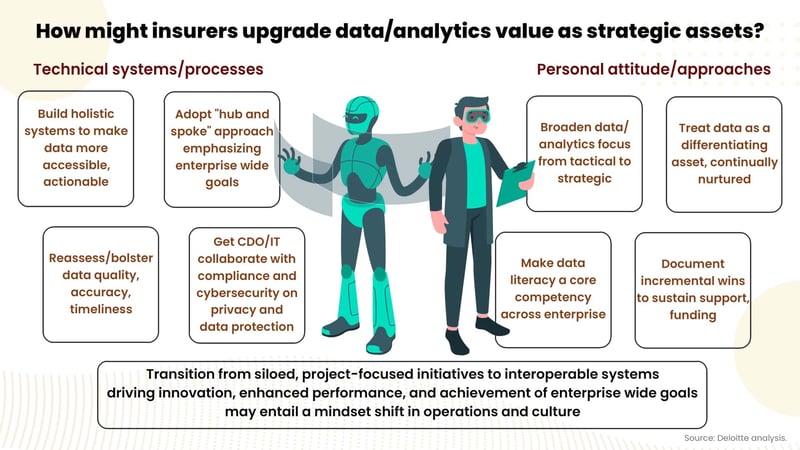How to Transform Your Mountains of Insurance Data into Actionable Insights

Data took center stage as a major buzzword in 2023, and its momentum has seamlessly carried into the current year. Insurance carriers, MGAs, and agencies need to harness the potential of both their proprietary data and third-party data to propel them toward informed and improved decision-making.
Insurance data has always been a rich source of insights but unifying disparate data sources or the continued dependency on manual entry into spreadsheets is going to get insurers nowhere. In the digital age, everything needs to be real-time and almost instantly accessible. If you are not yet using your data to the optimal limit then it is time to find a way to get across these challenges because the quality of your data determines your company’s ability to scale, compete, and thrive.
Insurance Big Data needs Automation
While insurance data is abundant, actual actionable information remains elusive for most insurance companies. Insurers still struggle to unify data but the challenge does not stop here, converting the raw data into actionable insights is a lot of work. Without automated data management, this would be a formidable task.
Data Automation is the strategic approach of utilizing software to automate manual tasks and processes traditionally performed by humans. It does not imply a complete replacement of all data management activities with software but aims to enhance efficiency by automating specific steps in existing data management processes.
Automation of big data in insurance involves automating the extraction, transformation, and loading of data from different sources into one central hub. This daily grind of identifying the newly added data between different connectors and cleaning it into the standardized format can take hours. Yet, this would hardly be a blip in the day's proceedings when automation comes into play as the process can roll on its own without requiring human intervention.

What Happens in Automated Data Management
Data automation is a game-changer in handling diverse data types, covering structured data like flat files and databases, and unstructured data encompassing images, text, voice, and video. This transformative approach extends its reach across a spectrum of data sources, including internal databases, external databases, cloud-based data, and information from third-party applications, web services, and APIs.
Insurance data automation works across a spectrum of data sources, including internal databases, external databases, cloud-based data, and information from third-party applications, web services, and APIs.
Insurance data automation embraces a variety of cutting-edge technologies, from robotic process automation (RPA) to artificial intelligence (AI), machine learning (ML), and robust data integration tools. The power of AI and ML technologies shines through as they automatically analyze and extract valuable insights from the data.
Automated Data Management Tools Take Over Specific Aspects of Information Handling:
-
Data Quality: Enhancing or cleaning up data, such as matching customer records from multiple sources.
-
Data Integration: Consolidating disparate datasets into a central location, like merging online and offline sales data to analyze the effectiveness of marketing campaigns.
-
Automated Reporting: Utilizing pre-configured reports to monitor key performance indicators in your business.
-
Metadata Management: Managing data descriptions, including database schemas and information on where to locate specific data within different databases.
-
Master Data Management: Facilitating the flow of accurate information throughout an organization to establish a single version of truth for each dataset. This ensures clean and consistent datasets within various business functions, such as customer records and product catalogs, managed through automation to avoid duplication across multiple systems and teams in your company.
After the data has been collected, validated, and cleansed, insurance companies can then integrate it into their systems and use it for analysis.
The Future of Insurance Insights will Rely on Data Automation
For numerous insurers, 2024 is poised to be the turning point when data truly begins to yield substantial returns. Here's a glimpse into three ways insurance data and analytics automation will come together in the upcoming year.
Accelerated Risk Assessment Through Diverse Data Sources
Today's property and casualty risk managers have a growing array of cutting-edge AI applications and tools for better risk visibility. Insurers can now harness extensive data from a myriad of channels, including publicly available sources and real-time data such as satellite imagery, weather data, water table statistics, and fire alerts.
Yet many insurers still struggle with getting accurate underwriting data. This is further compounded when carriers are working with independent agents and brokers because time is of the essence in providing a quote as brokers are also writing business with other carriers. Insurers are increasingly relying on AI and predictive analytics to provide automated insights.
For instance, auto insurance automation hinges on key data elements like motor vehicle reports for predicting accident likelihood, loss history reports for future incidents, and credit scores for pricing and underwriting. These accessible and automated components have led to the comprehensive automation of auto insurance today.
In Property and Casualty insurance alone, close to 800 billion dollars of premiums are written annually. This is the reason why automation of insurance data and analytics will have a profound effect on more accurate risk assessment.
Real-Time Personalized Communication Through AI Chatbots
Top-notch insurance data and analytics help insurers deliver better customer service. Timely access to accurate and comprehensive information about a customer's policy, claims, and other relevant details equips customer service representatives to respond promptly and effectively to inquiries.
NLP and Generative AI facilitate highly personalized communication throughout the insurance process, spanning initial quotes and underwriting to catastrophe alerts and claims adjudication.
This is best illustrated by Tara, the intelligent AI BOT which is seamlessly incorporated into the SimpleINSPIRE insurance platform. She is not only aware of an agent’s location within the system but also excels at offering context-based interactions. She uses Natural Language Processing (NLP) and can be trained as a full self-service option. Tara can even initiate external Insurtech services, displaying the outcomes directly within the SimpleINSPIRE insurance platform.
Empowering the Distribution Network with Data
Insurance data and analytics will reach a point of automation even for smaller insurers. Take it from Evan Greenberg of Chubb, speaking on CNBC, who said their ultimate goal in commercial lines is to ask just two questions about a business—its name and address—and then generate a quote based on the available data.
A surge of accurate data from diverse sources, coupled with advanced AI tools, will supercharge the distribution network's capabilities. This includes streamlined coverage shopping, quote generation, and simplifying insurers' efforts to help policyholders comprehend their benefits.
In conclusion, treating data as a strategic asset not only unlocks new efficiencies, insights, and capabilities but also paves the way for the integration of emerging technologies. Achieving real-time or near-real-time data processing requires robust systems.
Schedule a demo with our experts today to experience firsthand the transformative impact of our state-of-the-art technology on your insurance processes. Your journey toward a more efficient, customer-centric, and data-driven future can start right here!
Topics: Intelligent Automation








